Chris Hardwick's Blog, page 400
December 28, 2023
ONE PIECE Live-Action Fans Will Adore These Youtooz Figures
If you, like me, have fallen deeply in love with Netflix’s live-action One Piece adaptation, then you’ll want to pay close attention to the Youtooz figures I’m about to show you. Because even though One Piece is a massively long-running franchise, the live-action version is so new there just isn’t much merch around for it yet. And while we’re hopeful that will change, we nerdy creatures are itching to fill our shelves with representations of Netflix’s live-action adaptation now. And that’s why I, for one, am truly thankful for Youtooz’s line of One Piece figures celebrating the live-action in specific. Not only are they incredibly well-done and detailed, as all Youtooz figures are, but they really capture the earnest heart of the live-action series. Let’s take a look.
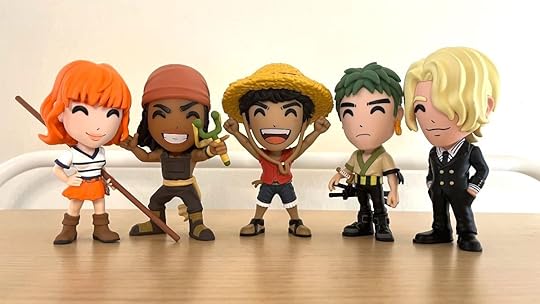 YoutoozYoutooz’s Live-Action One Piece Luffy Figure
YoutoozYoutooz’s Live-Action One Piece Luffy Figure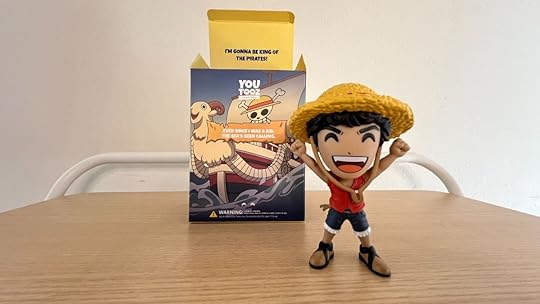 Youtooz
YoutoozI dare you to look at this Luffy figure and not crack a smile! Dare you! The future king of the pirates is in fine form, and you can just tell that he wants you to follow your dreams and succeed in all you do.
This live-action Luffy figure comes with Luffy’s signature hat and a victorious pose. His beautiful box reminds us all of his dream and features everyone’s favorite ship, the Going Merry. The sea and this little Luffy are calling. I promise you, you need him in your life.
Youtooz’s Live-Action One Piece Zoro Figure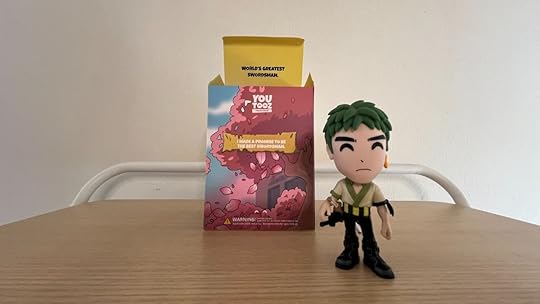 Youtooz
YoutoozZoro’s box is a little bolder than Luffy’s. It proclaims he’s the world’s greatest swordsman. And even though he isn’t yet, he will be because he made a promise.
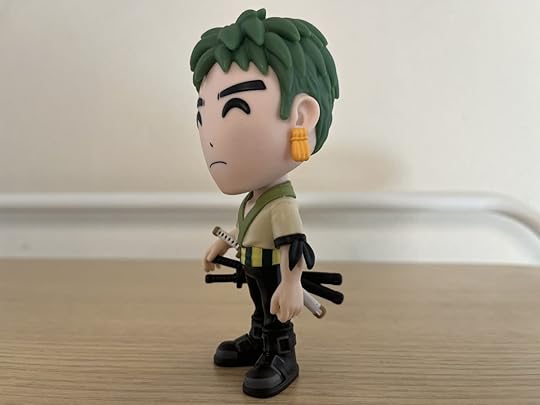 Youtooz
YoutoozWe also absolutely adore that Zoro’s box is decorated with falling cherry blossoms. To me, that says that whoever designed this figure really knows the heart of One Piece‘s live-action Zoro (which is caring and good, even though he probably doesn’t want you to know that.) There’s a softness to the whole figure, which I adore. And, of course, Zoro comes with his signature three swords, including the Wado Ichimonji (or Wado Itchy Monkey, as Luffy would say) and his three dangling earrings. What’s not to love about this Zoro figure?
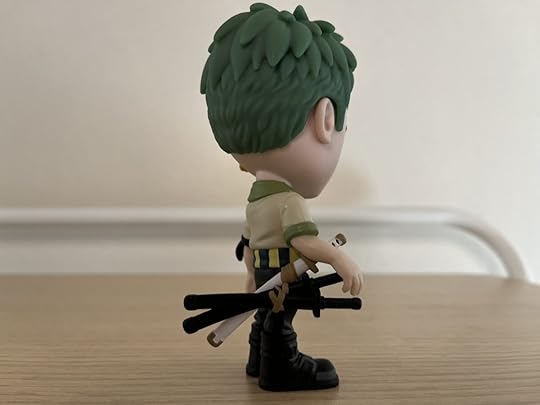 YoutoozYoutooz’s Live-Action One Piece Usopp Figure
YoutoozYoutooz’s Live-Action One Piece Usopp Figure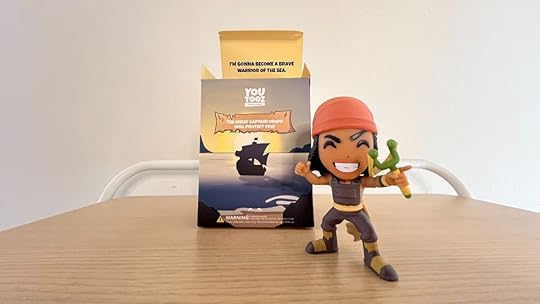 Youtooz
YoutoozLike Luffy, Usopp’s smile just makes you happy. You can tell that he’s going to not only be a brave warrior of the sea, but one of its most noble. In the live-action One Piece series, we see Usopp’s gigantic heart and cheery attitude shine, and this figure captures all of those qualities. With his trusty slingshot in hand, Usopp is ready to protect all those in need and defend the good from any possible evil that wishes to encroach.
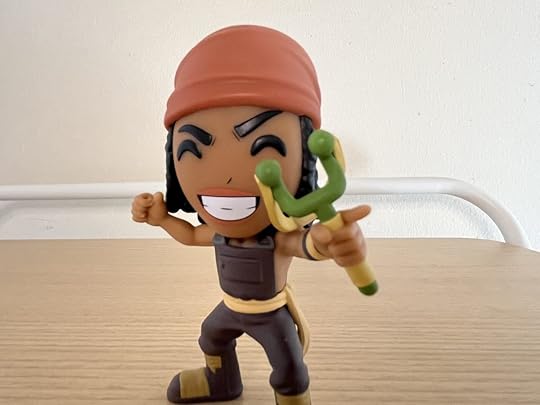 Youtooz
YoutoozThree cheers for the Great Captain Usopp!
Youtooz’s Live-Action One Piece Sanji Figure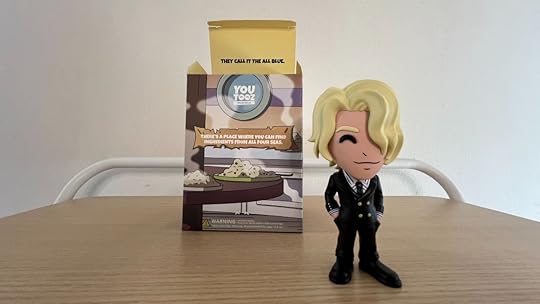
I would say that of all the characters in Netflix’s One Piece, Sanji underwent the biggest transformation from manga/anime to live-action, so I’m thrilled that this figure celebrates Taz Skyler’s rendition of the cook. In the live-action, Sanji is earnest, emotional, and stubbornly ready to help out his crewmates (whether they want him to or not). But, of course, his ultimate dream is to find the All Blue and taste ingredients from all over One Piece‘s universe. Until that happens, this Youtooz figure will let him watch over your kitchen.
Youtooz’s Live-Action One Piece Nami Figure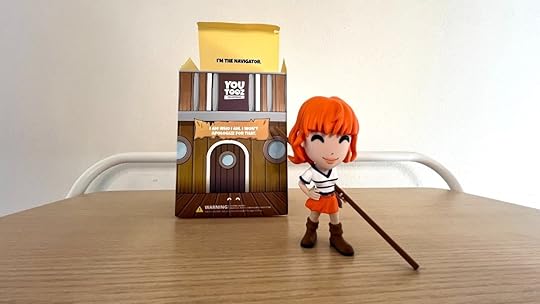 Youtooz
YoutoozAs it says on the box, Nami is the ship’s navigator, and she knows exactly who she is. We wouldn’t cross Nami even without her staff, but this Youtooz figure really drives home that point. We also love the brightly colored notes on this figure, which perfectly balances One Piece’s live-action and anime roots.
Youtooz’s live-action One Piece figures are now available for pre-order. They each cost $29.99.
The post ONE PIECE Live-Action Fans Will Adore These Youtooz Figures appeared first on Nerdist.
December 27, 2023
Why Marvel’s Classic ’70s Comics Should Inspire the MCU BLADE
In Hall H at San Diego Comic-Con in 2019, the crowd went wild, and the internet blew up when Kevin Feige announced a Marvel Studios Blade film starring two-time Oscar winner Mahershala Ali as the titular vampire hunter. Well, after one delay after another, Blade still hasn’t hit theaters. And its production is rumored to be fraught with issues. We’re not going to comment on the validity of any rumors, but clearly, something is up behind the scenes. It seems to be a script they just can’t crack. In this instance, we believe the filmmakers should just go back to the original comics for inspiration. And by “the original comics,” we mean Marvel’s ’70s horror masterpiece, Tomb of Dracula, where Blade first originated.
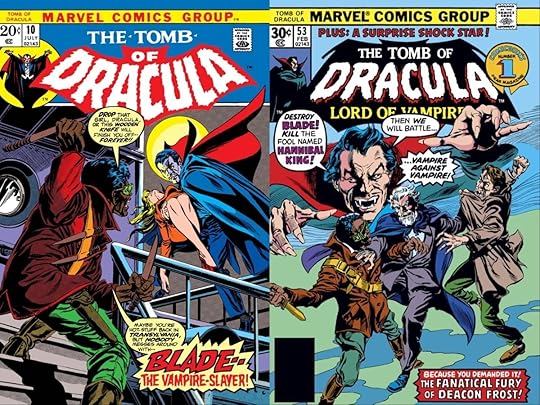 Marvel Comics
Marvel ComicsMarvel Studios has gone through multiple scripts and more than one director for Blade, and it seems that no one can decide which direction to go in. Is it PG-13 and family-friendly? Is it going to be a hard-R horror/action hybrid like the original Wesley Snipes films? It’s all unclear. And while the Snipes movies are the very reason why the character of Blade is an international icon today, the best thing a Blade MCU reboot should not be is too much like that version. Simply put, we’ve seen that. In fact, we think they should go back to the original Marvel Comics source material for inspiration.
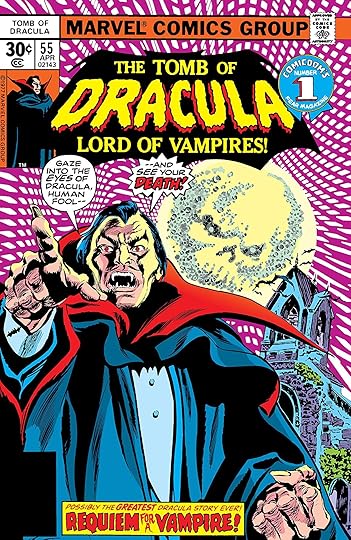 Marvel Comics
Marvel ComicsOne of Marvel Comics’ biggest villains in the 1970s was none other than the Lord of the Vampires himself. He starred in his own ongoing series Tomb of Dracula, which lasted 70 issues, from 1972 to 1979. Most of these issues were crafted by writer Marv Wolfman and artist Gene Colan. The stories were heavily inspired by the old Universal horror films, as well as the Hammer horror from the U.K., told with a Marvel flair. Despite the series having the name Dracula in it, the Transylvanian Count was not the protagonist. He was a straight-up villain, without any of the internal conflict we’d see later in more modern vampires.
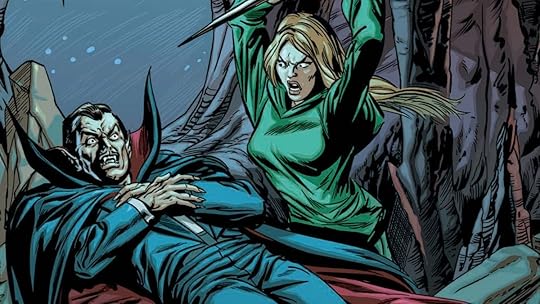 Marvel Comics
Marvel ComicsThe true lead characters of Tomb of Dracula were a group of vampire hunters with a personal vendetta against the undead Transylvanian Count. They were Frank Drake, Dracula’s human descendent; Rachel Van Helsing, granddaughter of Dracula’s sworn enemy; Quincy Harker, son of the protagonists in Bram Stoker’s novel; and a brand new, non-legacy character—Blade, the Vampire Slayer. Blade was a Black hero in the tradition of action stars of the time. Like Shaft star Richard Roundtree, only with wooden stakes and crosses instead of guns. Debuting in Tomb of Dracula #10 in 1973, Blade had another secret weapon—a vampire’s bite would not affect him due to the circumstances surrounding his birth..
 Marvel Comics
Marvel ComicsIn the comics, Blade isn’t American like he is in the Wesley Snipes films, he’s British. Like his Hollywood counterpart, Eric Brooks became a hybrid being when his pregnant mother was bitten by a vampire during labor. That vampire was Deacon Frost. This allowed Blade to grow up immune to vampire bites, and gave him a prolonged lifespan (but not immortality). But the other vampire abilities were not his. In the comics, those wouldn’t arrive until after the 1998 film, once Morbius, the Living Vampire bit him. He then acquired the thirst for blood, but took the blood via injection. Aside from the part about Deacon Frost and his mother, the comic book Blade and the movie Blade differ significantly.
In the comics, Blade was born in London in 1922, and grew up in the brothel his mother worked at. In 1929, he came upon a man being attacked by vampires in the street. That older gentleman, jazz musician Jamal Afari, was actually a vampire hunter himself from the United States. He took Eric Brooks in, and as his mentor, taught him everything he knew about the undead. After Dracula turns Afari into a vampire, it forces Blade to kill the only father figure he ever knew. Now dedicated to a life of vampire hunting, he met Frank Drake, Rachel Van Helsing, and Quincy Harker (the son of Jonathan and Mina Harker from Bram Stoker’s novel) and the group of vampire hunters would have many adventures together.
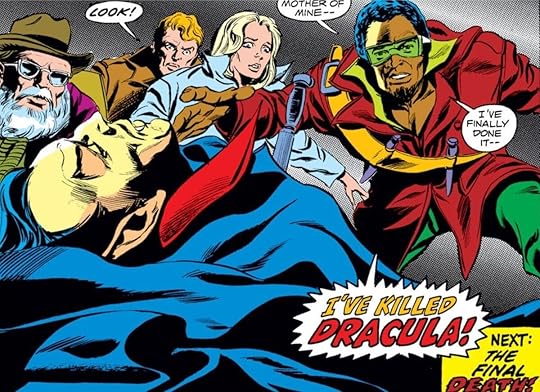 Marvel Comics
Marvel ComicsThe Blade who debuted in comics was a very different character than the one we met in the 1998 film starring Wesley Snipes. The first film kept the broad strokes of his origin story, but lost a lot of the classic horror flavor of the comics. This made sense for the time. Comic book movies were practically dead after a series of campy efforts like Batman & Robin. Some of the more fantastical elements of the comics might not have hit with audiences back then. But this is a post-MCU world. So Blade in the 21st century needs to adjust. We think it should still be gritty and harder-edged, yes. But as Werewolf by Night showed us, something closer to classic horror, with a gothic atmosphere and lots of monsters, absolutely can work in the MCU.
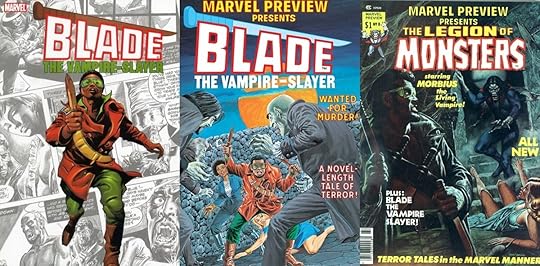 Marvel Comics
Marvel ComicsIn 1991, Blade would get a revamp to fit the new decade, and appear in a solo series and in Nightstalkers. He’d get his black leather jacket, lose the goggles, and cut his hair short. A very “edited for children” appearance on Spider-Man: The Animated Series would introduce his mentor Whistler, who would later appear in the film. All of these things would inform the Wesley Snipes iteration of Blade in some form. However, we still think Blade’s best stories came from those old Tomb of Dracula comics, and the issues of Vampire Tales starring Blade that spun off from them.
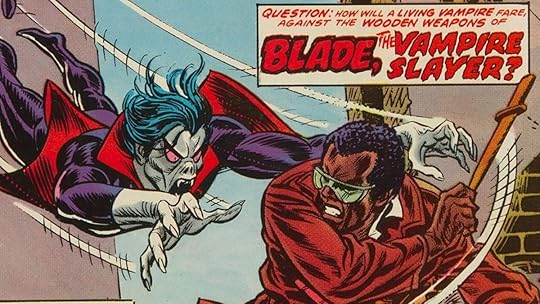 Marvel Comics
Marvel ComicsWe also think making the film a period piece would give it extra flavor. If they set the film in the era the comics were published, we could get some of that ‘70s flair in the character. We’d love to see Blade wearing that green or even orange trenchcoat, those wild goggles, and the bandolier with wooden stakes. No one would confuse MCU Blade with Snipes’ version after that. This is a Blade that lives in a world of Asgardian gods and Moon Knights after all. Don’t be afraid to go big Kevin Feige, and go weird. Otherwise, the MCU Blade film will just be a pale imitation of the Wesley Snipes version from years ago. And no one wants that.
The post Why Marvel’s Classic ’70s Comics Should Inspire the MCU BLADE appeared first on Nerdist.
STRANGER THINGS 4 Leaves the Upside Down for LEGO World in Young Animator’s Remake
Spider-Man: Across the Spider-Verse is a true triumph of the medium. It’s one of the best looking, most innovative films ever made. But one artist who worked on it really stood out. An all-time great animated movie included a sequence made by a 14-year-old. The team behind the franchise was so impressed with Preston Mutanga‘s LEGO recreations they tasked him with bringing the movie’s LEGO Spider-Man section to life. Obviously he’s a real prodigy. And yet, despite knowing all that, we’re still awed by one of his recent remakes. He created Stranger Things 4: Volume 2‘s trailer in LEGO. It has us ready to battle the original and mini-fig versions of Vecna. However, we’d really prefer if all versions of Hawkins took care of him without us. Watching, in any form, is way less stressful than actually fighting.
Forget the Upside Down, Stranger Things 4 heads to LEGO World in (now 15-year-old) Preston Mutanga’s take on the hit Netflix series. From Eleven and friends, to Hopper and Joyce, to the California crew, to poor Eddie Munson, everyone is along for this plastic brick war against true evil.
They’ll need to work together, too. Even in minifigure form, Vecna is super creepy. Even at roughly 1.5-inches tall he’d freak us out.
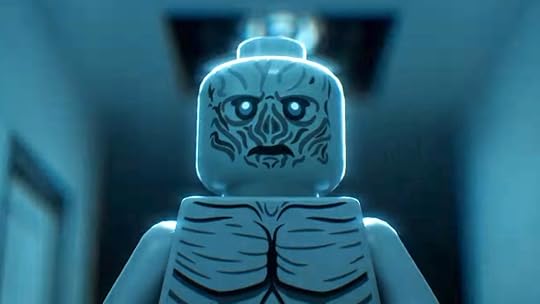 Preston Mutanga
Preston MutangaThis isn’t good because a kid made it. This is a fantastic way to re-experience one of Stranger Things‘ best seasons. If you didn’t know about the original series you’d think it really was a LEGO show for adults.
It’s so good it has us ready to fire up Netflix for a rewatch. (That desire doesn’t apply to listening to Kate Bush’s “Running Up That Hill,” though, because we’ve never stopped playing it since it helped save Max.)
And after we’ve finished rewatching Stranger Things 4 again? We’re putting Across the Spider-Verse on, obviously. We’ll never stop being awed by Preston’s work.
The post STRANGER THINGS 4 Leaves the Upside Down for LEGO World in Young Animator’s Remake appeared first on Nerdist.
This Fanmade LEGEND OF ZELDA Film Takes on Studio Ghibli’s Signature Style
We imagine fictional worlds colliding all the time. What would happen if the Doctor had a run-in with Darth Vader? Could Rick the weird scientist leave Morty behind and travel with Michonne from The Walking Dead? What if The Last of Us’ gaming world collided with Animal Crossing? (Now that would be wild.) We may never know the answers to these burning questions… unless you have fanfic that you’d like to share with the class. But we do know that The Legend of Zelda and the Studio Ghibli universe go together like peanut butter and jelly. YouTuber RwanLink used his creative chops to create Castle Town, a fanmade film set in The Legend of Zelda: Ocarina of Time‘s world with a Studio Ghibli aesthetic.
RwanLink put 600+ hours into his venture—which he created using Unreal Engine 5—with 30+ characters and a full storyline in the span of just one month. That’s basically a full-time job on top of whatever he does for a living. The love for fandom and creativity is apparent. The short film clocks in at less than 20 minutes and it is so visually stunning and comforting. It’s the perfect way to celebrate 25 years of Ocarina of Time. The character’s expressions and music compensate for the lack of dialogue as we follow Link on a brand-new adventure. And yes, we saw the teaser before, but this is a longer trailer with even more animation.
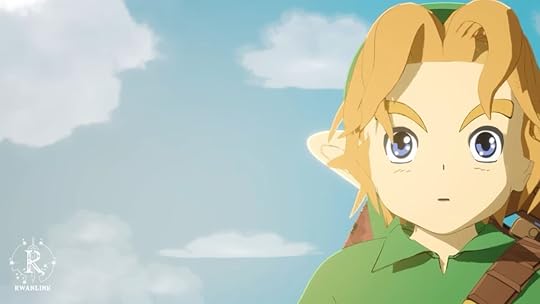 RwanLink/YouTube
RwanLink/YouTubeZelda fans took to RwanLink’s comments to give him lots of love. From praising his skills to simply thanking him for putting so much love and care into celebrating the game, there’s so many heartwarming exchanges. This speaks to the enduring power of both universes, which are still going strong after all this time.
We hope to see more of The Legend of Zelda fan films in the style of Studio Ghibli in the future.
The post This Fanmade LEGEND OF ZELDA Film Takes on Studio Ghibli’s Signature Style appeared first on Nerdist.
December 26, 2023
The 10 Greatest Wonder Woman Comic Book Runs, Ranked
She’s the most famous female superhero of all time, with comics published nonstop for over 80 years. And in those eight decades, Wonder Woman, both as a character and as a comic book title, has had many ups and downs. We’re here to count down to the best of the best, the greatest comic book creative team runs for Diana of Themyscira that truly defined DC Comics’ Amazing Amazon.
10. Wonder Woman (Vol.4) by Brian Azzarello and Cliff Chiangwith Tony Akins, Goran Sudzuka, Aco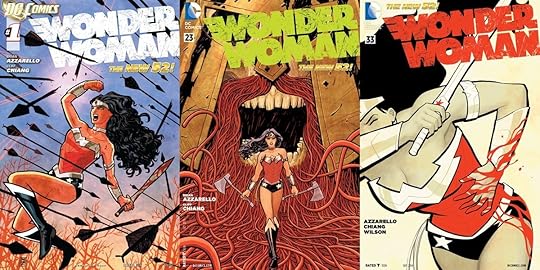 DC Comics
DC ComicsWhen DC rebooted its universe in 2011 in what it called “the New 52” initiative, no one got a bigger status quo change than Wonder Woman. Writer Brian Azzarello (100 Bullets) and artist Cliff Chiang’s (Paper Girls) run was critically acclaimed and sold very well. So why is it at the bottom of this list? It’s not a particularly good Wonder Woman comic. Much of it seems to disregard the original intent for Wonder Woman and the Amazons from her creator William Marston back in the Golden Age of comics.
In Azzarello’s take on Diana, she was not born of clay and given life by the gods with no male influence. Instead, she was the secret result of a torrid love affair between Zeus and Queen Hippolyta. The story revealed the Amazons as sexual assaulters and murderers of men, and then quickly removed them from the story. Azzarello’s reinterpretation of the Olympian Gods was extremely interesting, though, a highlight of the book. But they became more of a focus on the title than the titular heroine. DC would undo most of these changes, although Diana may or may not still be Zeus’ kid these days. DC doesn’t even seem to know. We do think some of the story choices here were bad for Wonder Woman. But objectively, as just a comic book about interfamily drama among gods, the craft on display is top-notch.
Issues in Brian Azzarello’s Wonder Woman run:Wonder Woman Vol.4 #0-34, (2011-2014)
9. The Legend of Wonder Woman by Kurt Busiek and Trina Robbins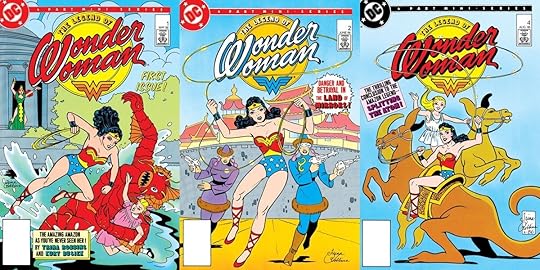 DC Comics
DC ComicsWriter Kurt Busiek is known for many legendary runs of comics for well-known heroes, specifically, Avengers, Superman, and his own creator-owned work, Astro City. In the mid-80s, he produced a love letter to Wonder Woman’s Golden Age heyday, along with underground comics legend Trina Robbins doing the art and helping with the plot. Robbins’ art style was a near-perfect mimic of Harry G. Peter, Diana’s principal artist in the ‘40s. Shockingly, Robbins became the first woman to illustrate Diana’s adventures, over 40 years after her creation. Hard to believe it took that long.
Released in 1986, this 4-part mini-series came out after Diana “died” in Crisis on Infinite Earths, but before her George Perez reboot. As the Amazons mourned their lost princess, her mother Hippolyta recalls an old adventure of her daughter’s. One where she battled Atomia, “Queen of the Atom Universe.” Told in complete retro style, this series featured many staples of ‘40s Wonder Woman. There was a precious little girl Diana befriends, and wacky super science. Plus, Wonder Woman always looking to rehabilitate an enemy before fighting one, a Golden Age staple. It was meant as a fond farewell to the Wonder Woman of old, and succeeds at doing so. Hopefully, one day DC will collect this fun throwback.
Issues in Kurt Busiek and Trina Robbins’ Wonder Woman run:The Legend of Wonder Woman Vol.1 #1-4, (1986)
8. Wonder Woman (Vol.1) by Robert Kanigher and Ross Andru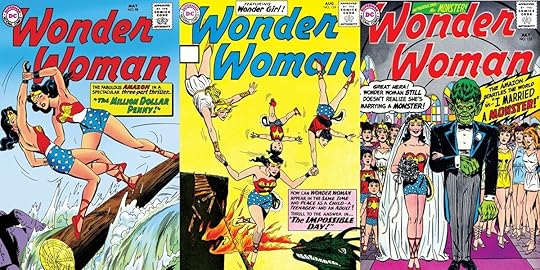 DC Comics
DC ComicsThe ten years of Wonder Woman stories after the death of her creator William Moulton Marston were mostly a dreary affair. The character was still popular enough that she survived the post-World War II decline in the popularity of superhero comics. But these uninspired stories focus too much on Diana’s romantic pining for pilot Steve Trevor. Then, the late ‘50s saw a renaissance in superhero comics, an era we now call the Silver Age. Wonder Woman got in on this change too, and the writer/artist duo of this time, Robert Kanigher and Ross Andru, produced some of the most off-the-wall (yet fun) Wonder Woman stories of all time.
During the Kanigher/Andru run, Diana got a new origin story. The first one where she had a father, the long-lost Prince Theno. The gods blessed her upon birth, hence her amazing powers. Following Superman’s lead, Diana had a “Wonder Family” of her own which included time-traveling versions of herself, like baby Wonder Tot and a teenage Wonder Girl. Wonder Girl was so popular, she would eventually evolve into her own, separate character for Teen Titans, Donna Troy. Silver Age Wonder Woman fought space aliens, and wacky characters like the Crimson Centipede, Angle Man, and even Paper Man.
Because of all these weird stories, clearly written with 8-year-olds in mind, Wonder Woman eventually began to feel like a relic of a bygone era. Especially as Marvel Comics grew in popularity as the ’60s rolled on. But many aspects of the Kanigher/Andru run stuck around in Wonder Woman lore. Although the idea of Diana having a father would go away by the early ‘70s, modern versions retain her being blessed by the Gods as a baby for example. Certainly not a complex series of stories, but filled with imagination just the same. And perfect for a young kid to read, even today.
Issues in Robert Kanigher and Ross Andru’s Wonder Woman run:Wonder Woman Vol.1 #98-170, (1958-1967)
7. Wonder Woman (Vol.2) by William Messner-Loebs and Mike Deodato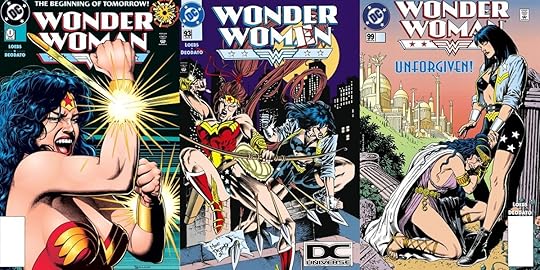 DC Comics
DC ComicsWe want to start by saying this run on Wonder Woman is somewhat problematic. The ‘90s art style of artist Mike Deodato is heavy on the cheesecake style, with Wonder Woman and her fellow Amazons practically all wearing thongs and overly sexualized togas. (We should add Deodato’s style has definitely evolved since then). But writer William Messner-Loebs’ storytelling skill was still on point, and made it so the reader can look past the extremely dated artistic elements. Messner-Loebs took over writing on Wonder Woman after five years of George Perez, who famously reinvented the character. An unenviable position, to be sure.
But after a couple of years of oddball stories, including one where Diana worked as a fast food employee, Messner-Loebs got to write his own Amazon epic. For twelve issues, he told the story of how Hippolyta was so disappointed in Diana’s failure to change the world, that she began a new contest to pick a new Amazon champion as Wonder Woman. The winner was Artemis, a surly Amazon from a militant tribe. One who thought she had what it takes to be a better Wonder Woman. But Diana didn’t quit the fight, even if she wore a hideous biker outfit to fight in now. This story is very “of its time,” but also fun. It introduced a very important member of the supporting cast in Artemis. Most importantly, it also reaffirmed why Diana was, and always will be, the best Wonder Woman ever.
Issues in William Messner-Loebs and Mike Deodato’s Wonder Woman run:Wonder Woman Vol.2 #0, 90-100 (1994-1995)
6. Wonder Woman (Vol.3) by Gail Simonewith Terry and Rachel Dodson, Aaron Lopresti, Bernard Chang, Matt Ryan, Nicola Scott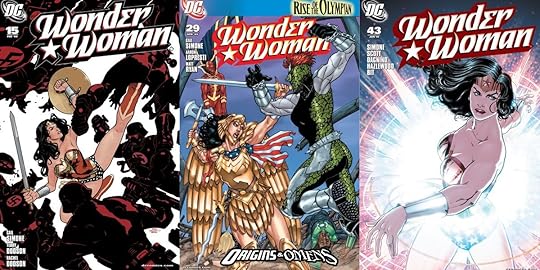 DC Comics
DC ComicsAfter successful runs on the female-centric Birds of Prey, fans wondered out loud when writer Gail Simone would take on Wonder Woman, a character she professed much love for. The day finally came in 2007, when Simon took over writing duties on the third volume of Wonder Woman, which had been plagued with writer turnover since it began. She wound up being the female writer with the longest tenure writing Wonder Woman ever. Simone’s run built upon much of what came before, even largely hated events like Amazons Attack. And it made lemonade out of lemons.
Gail Simone’s Wonder Woman stories weren’t mainstream newsworthy and attention-getting, and there was no major reveal or change to Diana’s personality or history here. It was just really good comic book storytelling. She also created some truly memorable villains like the Circle, a band of Amazons who believed Diana’s supernatural birth was an abomination. Also Genocide, her physical rival in the way Doomsday was for Superman. A villain with incredibly creepy ties to Diana herself I won’t spoil here.
She also found a way to address the other pantheons of Gods, and how they related to the Olympians who gave Diana her powers. The artwork, primarily from Aaron Lopresti and Bernard Chang, showed off how good they were at just telling a story. This run ended the storyline of Wonder Woman that Perez had begun in 1986, and we could think of much worse ways to go out. Plus, Gail Simone’s Wonder Woman had talking apes in it as a supporting cast. That alone makes this an all-timer.
Issues in Gail Simone’s Wonder Woman run:Wonder Woman Vol.3 #14-44, Vol.1 #600, (2007-2010)
5. Wonder Woman (Vol.2) by Phil Jimenezwith Roy Allan Martinez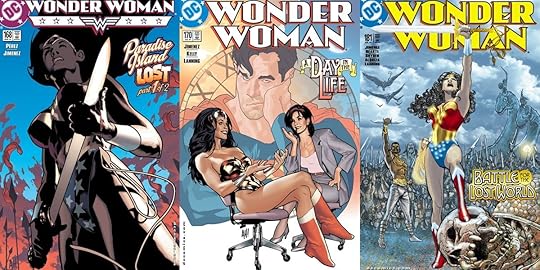 DC Comics
DC ComicsWhen writer/artist Phil Jimenez came on board the monthly Wonder Woman title in 2001, he was already a well-known super fan of the character. He’s even the author of the Wonder Woman Encyclopedia. However, by the time he took over, the book had drifted from its core, altering the character to fit into stories about other DC characters the current writer wanted to tell.
Jimenez, whose art style draws heavily from George Perez’s interpretation, explored ideas post-Perez creators just glossed over. What did it mean to have two different tribes of Amazons on one island? What did it really mean for Hippolyta to time travel and replace her daughter in World War II history? And what did it mean for Diana and Donna Troy to effectively share a soul? Jimenez crafted compelling stories around these lingering questions with some of the most gorgeously rendered art the series had ever seen, before or since.
Most importantly, Phil Jimenez crafted the best single issue of Wonder Woman ever, titled “She’s a Wonder.” It covered reporter Lois Lane tailing Diana for a full day, examining what 24 hours in her existence were really like. Turns out, it wasn’t as perfect as most would like to think. Jimenez’s run only lasted three years, but I felt his deep love for the character on every page. Luckily, he got to return to the world of Diana in the Wonder Woman prequel graphic novel Historia, itself a masterpiece. If there’s any creator we’d follow on a Wonder Woman project anytime, it’s Phil Jimenez.
Issues in Phil Jimenez’s Wonder Woman run:Wonder Woman, Vol.2, #164-188, (2000-2003)
4. Wonder Woman: Earth One, Vol. 1-3, by Grant Morrison and Yanick Paquette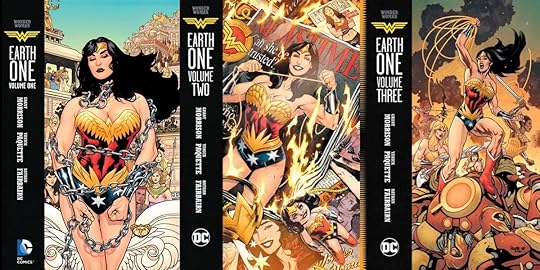 DC Comics
DC ComicsWriter Grant Morrison is a legend when it comes to writing comics, and has been for the better part of forty years. Their runs on X-Men, Superman, Batman, and JLA are among the best ever for those characters. They finally gave fans their take on Diana in a series of three original graphic novels, Wonder Woman: Earth One, which came out between 2017 and 2020. Joining on all three volumes of Earth One was artist Yanick Paquette. He had briefly drawn the ongoing Wonder Woman series in the late ‘90s, but now his craft was on another level. It’s safe to say his version of Paradise Island remains the most beautifully illustrated ever.
While most other writers since William Marston had shied away from the sexual and BD/SM aspects of Wonder Woman, Morrison leaned in hard. They explored why it was both great and problematic at the same time. Their Diana was finally openly bisexual giving her a girlfriend at last. They also restored one aspect of Diana’s lore that DC disregarded for years, which was the weird sci-fi angle. We acknowledge that Morrison’s Earth One version of Wonder Woman is a love-it-or-hate-it affair. Some moments are overblown and almost campy, and many modern readers don’t like to be reminded of the innate absurdity of superheroes, something Morrison absolutely loves.
And yet, Morrison did what they almost always do with their take on iconic superheroes. They take pieces from decades of lore, and fashion them into something new and modern while honoring the past. There’s almost no era of Wonder Woman comics Morrison doesn’t lovingly homage in Earth One. Even the bad ones. Elements from Perez, Messner-Loebs, and Greg Rucka are all here in some form. All refashioned as a statement on 21st-century misogyny, and how to fight against it. For that, Morrison and Paquette’s three-part graphic novel series is well worth the time of any Wonder Woman fan.
Issues in Grant Morrison and Yanick Paquette’s Wonder Woman run:Wonder Woman: Earth One, Volumes 1-3, (2017-2020)
3. Wonder Woman and Sensation Comics by William Moulton Marston, Harry G. Peter, Elizabeth Marston, Olive Byrne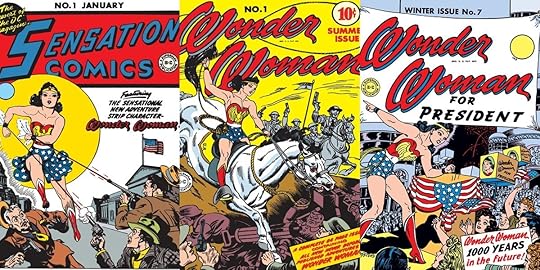 DC Comics
DC ComicsIn the cases of Diana Prince’s fellow Trinity friends Superman and Batman, their creators did not necessarily write their best stories. But in Diana’s case, her creator William Moulton Marston absolutely did weave some of her most formative tales, even if some aspects of them are cringe nearly 80 years later. It’s well documented how Marston, along with his wife Elizabeth and their partner Olive Byrne, wanted to create a modern feminist icon with Wonder Woman. Someone strong who would serve as the antithesis of the “bloodcurdling masculinity” of most comics back then.
With the help of artist and collaborator Harry G. Peter, whose art style was unique for the time resembling Victorian illustrations. Marston, Elizabeth, and Olive (who were uncredited) crafted stories of Amazonian super science, mythical lands, and bizarre villains. Perhaps more important were tales where Diana Prince helped her enemies become better people, and didn’t just throw them in prison and wait for their escape. Yes, some of these stories have problematic politics. Diana wasn’t so much for equality of the sexes, Marston believed women should rule over men. We don’t want to kink shame, but the focus on bondage imagery was over the top, and the less said about its depictions of the Japanese during World War II, the better.
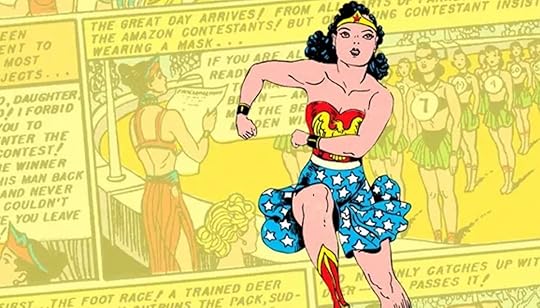 DC Comics
DC ComicsAnd yet, more than almost any other Golden Age superhero comics of the time, Wonder Woman and Sensation Comics remain incredibly readable today, even if you’re often thinking “Wtf is going on” while reading them. The stories are wildly entertaining, featuring one wonderfully bizarre concept after another. It’s no surprise that so many prominent American feminists were readers of these comics as little girls. When Marston died in 1947, it marked the end of five years of wild and weird stories, soon replaced by other writers who didn’t adhere to Marston’s feminist views. But despite massive changes to Wonder Woman after Marston’s tenure, the core of what he created in these stories remains, and always shines through.
Issues in William Moulton Marston’s Wonder Woman run:All-Star Comics #8, Sensation Comics #1-68, Wonder Woman Vol.1, 1-24 (1941-1947)
2. Wonder Woman (Vol.2, Vol.5) by Greg Rucka with Drew Johnson, J. G. Jones, Rags Morales, Cliff Richards, James Raiz, Nicola Scott, Liam Sharp, Bilquis Evely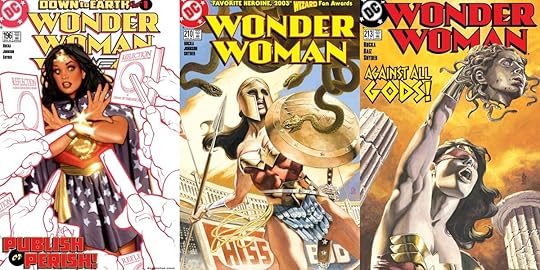 DC Comics
DC ComicsProlific comic book writer Greg Rucka, famous for his work on Batman, has not just one but two excellent runs on Wonder Woman. He first took over the series with issue #295 back in 2004. Many previous runs after Perez’s tenure on the title focused on traditional heroics. Yet Rucka chose to focus on Diana’s role as ambassador of Themyscira. Her main function in society was to help people become the best versions of themselves through example. She even wrote a bestselling book to get her point across.
But Rucka didn’t shy away from portraying Diana as the greatest warrior on Earth. In the graphic novel The Hiketeia, she shows Batman just who is the most skilled fighter on the planet when she upholds her sworn duty to defend a young woman. When she takes on Medusa, she blinds herself to fight her, proving she doesn’t need eyes to take her down. Rucka also deftly deals with the consequences of Diana’s moral failing, when she kills Maxwell Lord to save Superman (and countless others).
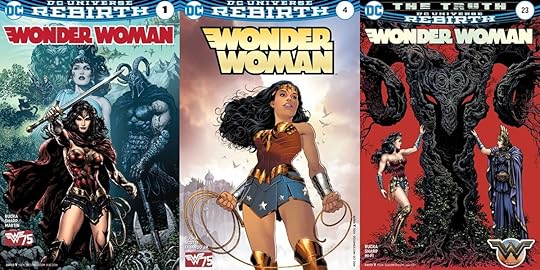 DC Comics
DC ComicsIn 2016’s Rebirth era, Rucka returned to Wonder Woman, this time restoring much of her original lore that was removed by the New 52 run. In “Year One,” Wonder Woman’s new origin story goes back to Marston’s original, while also keeping key elements of the Perez-era Amazons. For “The Lies,” Rucka and Liam Sharp address Diana’s role in the present time, and reimagine villains like Cheetah. Most creators are lucky to have one run on a particular superhero that is so great. Greg Rucka gets to say he had two.
Issues in Greg Rucka’s Wonder Woman run:Wonder Woman: The Hiketeia (2002) Wonder Woman Vol.2 #196-226 (2003-2006), Wonder Woman Vol.5, #1-25, Rebirth Special #1 (2016-2019)
1. Wonder Woman (Vol.2) by George Perezwith Greg Potter, Len Wein, Chris Marrinan, Jill Thompson, Colleen Doran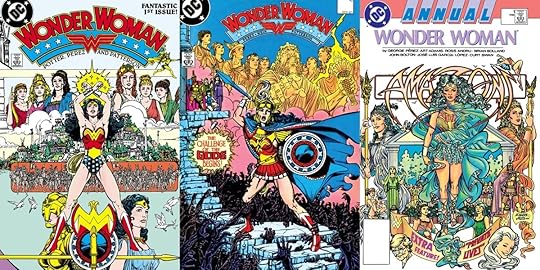 DC Comics
DC ComicsAfter the sales highs of the Golden Age, Wonder Woman as a comic book rarely sold like gangbusters. However, a clause in the contract with her creator’s estate meant DC had to publish Wonder Woman comics, or the company would lose the rights. Wonder Woman was too valuable as an IP due to merchandise sales to ever let her go but the actual comics were neglected creatively for years. The only exception was the bump when the Lynda Carter Wonder Woman series was on the air. DC used their big 1985 continuity reboot Crisis on Infinite Earths to give Diana a big makeover. The trouble was, no one wanted the job.
Artist George Perez was already a comics superstar thanks to his work on The New Teen Titans and The Avengers. When he finished drawing Crisis, he realized Superman and Batman had major creators doing their respective reboots; Wonder Woman had no one. So he volunteered, and along with writer Greg Potter, did a massive overhaul of Wonder Woman in 1986, bigger than almost anything that had been done before. Under their guidance, the Amazons became more like the warriors of Greek myth than ever before, and the importance of the Olympian pantheon went into overdrive. The artwork and stories were detailed and epic, somehow evoking ancient myth and modernity at the same time.
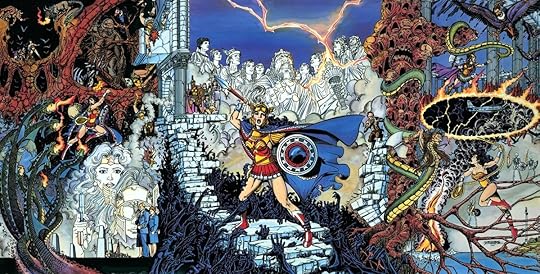 DC Comics
DC ComicsUnder Perez, Diana was powered up, befitting her status. She didn’t need an invisible plane to fly anymore, she could do so on her own power. Her super strength was now on par with Superman’s. Her longtime love interest, Steve Trevor, became an older man who was like a big brother. Perez was in no rush to give Diana a love interest. Perhaps the biggest change, the secret identity trope was done away with. Diana Prince was over, she was just Princess Diana, ambassador of Themyscira. Not only that, he made her principal supporting cast a single mother and daughter, amping the feminism of the title harder than anyone since Marston himself. However, unlike Marston, fewer people were tied up.
Perez illustrated the book for only 25 issues, but wrote (and did covers) for the entire five-year run. Sales and critical acclaim for Wonder Woman were better than they’d been in decades, and it was the foundation for the next two decades of Wonder Woman storytelling, including many of the other great and creative runs on this list. Both the modern animated and live-action versions of Wonder Woman owe George Perez an incredible debt for his version of Princess Diana. For this reason, we rank it as the greatest of all time.
Issues in George Perez’s Wonder Woman run:Wonder Woman Vol.2, #1-62, Annual #1-2, Wonder Woman: War of the Gods #1-4 (1986-1991)
The post The 10 Greatest Wonder Woman Comic Book Runs, Ranked appeared first on Nerdist.
The GOOD OMENS Theme Song Gets a Whimsical Orchestral Performance
Anyone who knows me knows I am a sucker for all types of theme songs. While sitcom themes are my faves (“Movin’ on Up” is a JAM), I also love a good tune to accompany fantasy and sci-fi adventures. Even those who aren’t familiar with Game of Thrones have probably heard its epic theme music before. The same can be said for Doctor Who’s strange yet delightful “dooo-wee-ooooh” tune and Good Omen’s ethereal waltz. Speaking of the latter, we stumbled across a version of it fans have to hear. During the 2023 BBC Proms event at Royal Albert Hall, the Huddersfield Choral Society and a lovely orchestra brought new life to the Good Omens theme song. And yes, it is ineffably great.
This song truly captures the essence of the adventures of Aziraphale and Crowley. The first two seasons of Good Omens have been quite the wild ride for fans. Hopefully, the show’s planned (but not yet confirmed) third season will move forward and bring this story of an angel and a demon who form an unlikely “friendship” (wink, wink) while thwarting an apocalypse to an end. I’d personally love to see these two dance to this version, although the original is forever a banger.
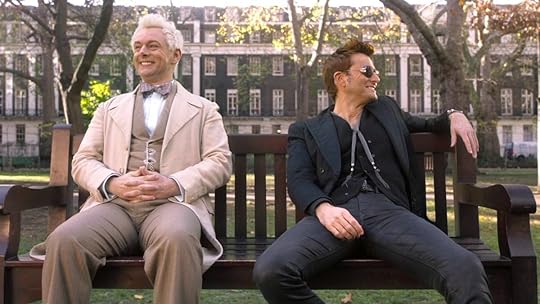 Prime Video/BBC Studios
Prime Video/BBC StudiosWe hate to see a good thing come to an end. But it is better to 1) get an actual ending and 2) get an ending before said good thing goes off the rails. It is, after all, Neil Gaiman’s ineffable plan to end the story with three seasons. Thankfully, we will always have this orchestra version of the Good Omens theme song to vibe to.
Also, I totally want to be in that choral society collective now. I cannot sing well but maybe I can “ahhh” in unison.
The post The GOOD OMENS Theme Song Gets a Whimsical Orchestral Performance appeared first on Nerdist.
MADAGASCAR’s Penguins Face Peril in BALDUR’S GATE 3 Mashup Video
It seems like, for many people, Baldur’s Gate 3 is a nearly perfect game. After all, it offers you all the fun of Dungeons & Dragons and all the thrills of a well-made video game. Not to mention, its characters are incredibly romanceable, and its story is well-woven and full of nuance. But, I think we can also all agree that one thing desperately missing from Baldur’s Gate 3 is more penguins. Are there any penguins in the game? I couldn’t swear there aren’t, but even if there are, they are most definitely not Madagascar‘s set of hilarious birds. But fear not, an intrepid fan has made the mashup of our dreams. Get your battle armor on and strap in, because Madagascar‘s penguins flap right into the world of Baldur’s Gate 3 in this hilarious video.
Karlach and penguins? Gale and penguins? Be still our beating hearts! The only thing missing obviously is Madagascar‘s penguins meeting Baldur’s Gate 3 fan-favorite Astarion. But maybe that’s for the sequel mashup video. We have to commend creator eli_handle_b․wav, the combination of movies is seamless here. We really do feel like these brave penguins are fighting monsters and chitchatting with our favorite heroes and co. And honestly, this video really is just laugh-out-loud funny. It should greatly delight any fans of Baldur’s Gate 3.
Click To View Gallery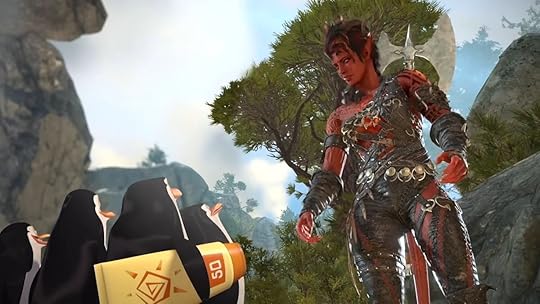 eli_handle_b․wav
eli_handle_b․wav 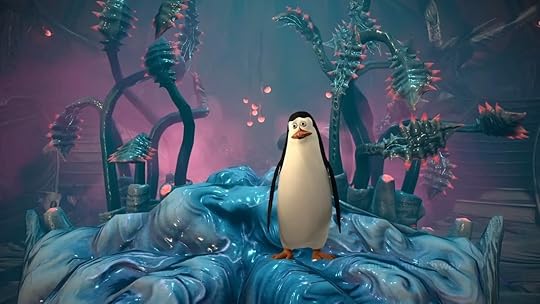 eli_handle_b․wav
eli_handle_b․wav 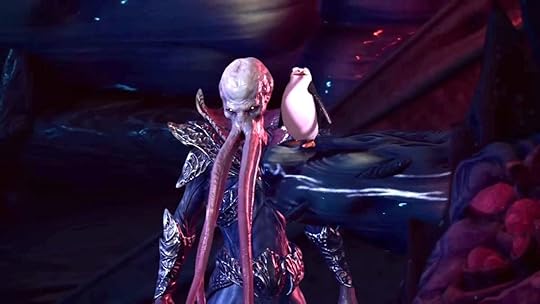 eli_handle_b․wav
eli_handle_b․wav 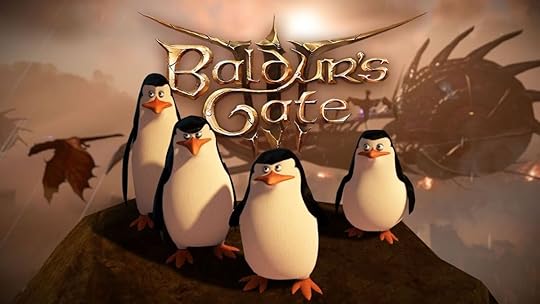 eli_handle_b․wav
eli_handle_b․wav Right now, we don’t think there are plans to bring penguins in as playable characters in Baldur’s Gate 3. But maybe there really ought to be. After all, these birds have moves, they have jokes, and they certainly are not afraid of a little danger. True-heart paladins if we ever saw any… Or well, they try. “There is no greater sacrifice than someone else’s” feels like a very chaotic good statement to us. And hey, there’s always character development.
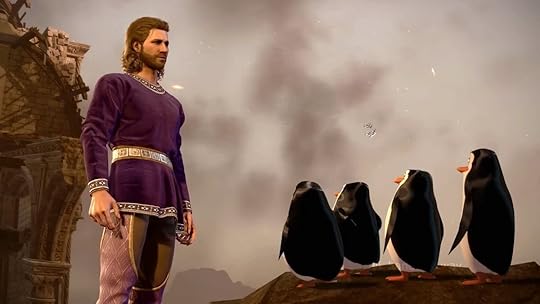 eli_handle_b․wav
eli_handle_b․wavPenguins of Baldur’s Gate 3, we salute you.
The post MADAGASCAR’s Penguins Face Peril in BALDUR’S GATE 3 Mashup Video appeared first on Nerdist.
December 25, 2023
Who Is Mrs. Flood in DOCTOR WHO? Ruby’s Mysterious Neighbor Raises Eyebrows
“The Church on Ruby Road” gave us a really cute Christmas special starring the Fifteenth Doctor and Ruby Sunday. We met Ruby’s delightful family, including her loving adoptive mum Carla and her witty gran Cherry. Her neighborhood is also delightful, including her neighbor Mrs. Flood, played by Anita Dobson. The special teases an ongoing mystery about Ruby’s biological family but something strange is also going on with Mrs. Flood, too. She breaks the fourth wall at the end and it makes us all wonder what’s going on with her. Who is Mrs. Flood in Doctor Who? Let’s dig into how she appears in the episode and what she could do in the future.
 James Pardon/BBC Studios
James Pardon/BBC StudiosNear the beginning of the episode, Ruby Sunday comes home with two handfuls of groceries. We watch her neighbor Mrs. Flood argue with Abdul, another neighbor, about a large object that she’s sure he put on the sidewalk. That object is none other than the TARDIS. Abdul insists he knows nothing about this blue box. Ruby comes up and Mrs. Flood, who calls her Rubes, complains to her as Ruby looks at the box with lots of curiosity. She asks Mrs. Flood what it is and her neighbor says it is a police box. She admits she hasn’t seen one on the streets of London in around 50 years… and doesn’t want to see one now.
Later in the episode, Mrs. Flood is walking home when she witnesses the TARDIS dematerializing. Of course, she’s in shock and drops her shopping bags. After the Doctor returns from saving baby Ruby in the past, he parks the TARDIS on the other side of the street. Mrs. Flood is rather chipper and waves hello to him. When he comes back out, they have a short conversation, including Mrs. Flood asking who he is. Predictably, the Fifteenth Doctor just says he’s passing through and she tells him to take care. At the end, Ruby comes out to inquire about the Doctor and Mrs. Flood points her to the TARDIS. Strangely, she calls her Ruby and wishes her good luck. Mrs. Flood is even nice to Abdul, who is shocked to see the TARDIS disappear. She then turns directly to the camera and says “Never seen a TARDIS before?”
 BBC/Bad Wolf Studios/Disney+What Is Going on with Mrs. Flood in Doctor Who?
BBC/Bad Wolf Studios/Disney+What Is Going on with Mrs. Flood in Doctor Who? So, what’s up with this lady? Well, she clearly didn’t know what the TARDIS was at the beginning of the episode. There would have been no reason for her to put on a front (and argue) with Abdul if she knew the truth. It’s plausible Mrs. Flood did a bit of research after seeing the TARDIS leave. She’s an older lady but that doesn’t mean she can’t use the internet, right? However, the Doctor was only gone for a short amount of time. Did she have time to even look it up? Hmmm.
It’s not impossible that Mrs. Flood could have seen the TARDIS when the Doctor went back to that church on Ruby Road. It was a dark and wintry night and other houses were around. This episode revolved around coincidences, after all. Some fans wonder if Mrs. Flood is Ruby’s mom and we aren’t sure that’s the case. Ruby is 19 years old while Mrs. Flood appears to be in her 70s or maybe even 80s. Yes, some women do have children later in life but it’s a little too coincidental that she’d abandon Ruby and then end up being her neighbor. However, she could know more about Ruby than she’s letting on.
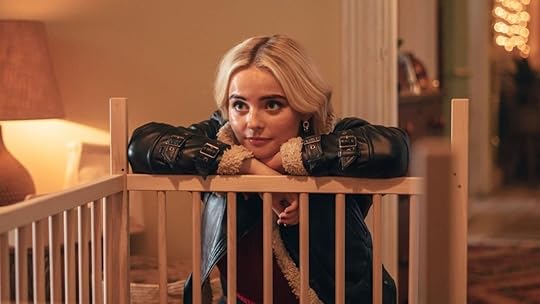 BBC Studios/Bad Wolf
BBC Studios/Bad Wolf Hell, maybe Mrs. Flood is a villain. A flood is an influx of rain and rain is an anagram for… RANI. (I’m kidding about the Rani… or am I?) Or, there could be no mystery with Mrs. Flood and she simply said that line for funsies. Anita Dobson grew up watching Doctor Who, so perhaps it’s just a fun nod to her being a fan. It seems a bit too deliberate to just be this but who knows what Russell T Davies has in store.
Will Mrs. Flood Return to Doctor Who?Either way, it seems we will get more Mrs. Flood in the future. You don’t score a legend like Anita Dobson and only use her once, right? During a charity appearance, Dobson hinted that her character’s nosy nature could draw her into the Doctor’s adventures. We will surely return to Ruby’s home life in Doctor Who season one and that’s where Mrs. Flood is. Hopefully, the questions we have about her will get answers as the Fifteenth Doctor and Ruby Sunday’s journey continues.
The post Who Is Mrs. Flood in DOCTOR WHO? Ruby’s Mysterious Neighbor Raises Eyebrows appeared first on Nerdist.
How Did the Fifteenth Doctor and Ruby Sunday Meet in DOCTOR WHO’s Christmas Special?
Doctor Who’s Christmas special, “The Church on Ruby Road,” is truly the beginning of something new. The Fifteenth Doctor gets into a strange Earth adventure, complete with singing goblins and a new friend named Ruby Sunday. Fans have been (impatiently) waiting to see how this new TARDIS team would come together for a while. Now, we know how the Fifteenth Doctor and Ruby Sunday meet in Doctor Who.
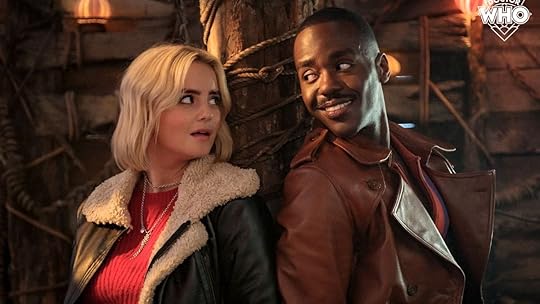 BBC Studios/Bad Wolf
BBC Studios/Bad Wolf The Fifteenth Doctor is in London, hitting up clubs and keeping an eye on a young woman with “bad luck.” The Doctor is certain something more sinister is going on involving her constant mishaps. Meanwhile, Ruby is on her own mission to find out information about her birth parents. She was named Ruby because she was left at a church on Ruby Road on a Sunday. Her adoptive mum Carla adores her but also supports her desire to know where she came from.
Ruby Sunday and the Fifteenth cross paths a couple times, including her watching him on the dance floor, before they meet in the most Doctor Who way possible. She chases a few hissing goblins to her rooftop in an attempt to retrieve her new foster baby sibling from their clutches. The intrepid Ruby jumps onto a hanging ladder of a ship without thinking (how Doctory of her) just as the Doctor appears. His tracking skills always lead him to the right place at the right time.
He’s running across the rooftops and yelling at her about jumping onto a random ladder. Of course, he joins her and, from that moment on, they are like peanut butter and jelly. They do a musical number on the fly, save the baby, and the Doctor even goes back in time to rescue baby Ruby. And those goblins? Well they feed off of a person’s luck as well as coincidence. The baby sharing a birthday with Ruby and arriving on her birthday? Yeah, that makes for a perfect meal. He doesn’t even give her an official invite to travel with him. The Doctor just knows that Ruby will piece it together and come into the TARDIS for answers.
The Fifteenth Doctor and Ruby Sunday’s dynamic feels reminiscent of Ten and Donna in a sense. They deliver witty comebacks and boundless energy with ease. But we know that Ncuti Gatwa’s Doctor is not quite like any other before him, so this will be a unique union. Their connection over being abandoned as children and having a nebulous past is a nice anchor. And with the mystery surrounding Ruby’s birth mother and her strangely knowledgeable neighbor Mrs. Flood, the Doctor will have lots to unravel during their travels.
The post How Did the Fifteenth Doctor and Ruby Sunday Meet in DOCTOR WHO’s Christmas Special? appeared first on Nerdist.
DOCTOR WHO’s Millie Gibson on Ruby Sunday’s Personality, a Dark Future, and Filming Fun
There’s always something exciting about a new companion coming to Doctor Who. Whether we love or hate their predecessor, the next TARDIS traveler ushers in new energy, hope, and perspectives. This is certainly the case with Ruby Sunday, who meets the Doctor in this year’s Christmas special “The Church on Ruby Road.” She inadvertently ends up on a goblin ship with the Fifteenth Doctor and her life will never, ever be the same again. We caught up with actress Millie Gibson to talk about Ruby Sunday’s effervescent personality, her favorite filming moments, what to expect next season, and so much more.
Nerdist: Ruby Sunday is absolutely delightful in “The Church on Ruby Road.” I can’t wait to see where she goes next! When it came to crafting her persona, how much input did you have?
Millie Gibson: When I first auditioned, I guessed [about her personality] because with an audition, they really barely give you anything. I think the words used to sum her up were “charismatic, bubbly, and craving adventure.” But I was like, “Isn’t that like every companion?”
I think as the process went along, [showrunner] Russell [T Davies] helped me by giving me a few pointers. She’s very positive and that there’s always an underlying mystery about her, however, it doesn’t get her down. She’s just onto the next thing. I remember him telling me, “She’s a person that never rolls her eyes to something and there can’t be any hint of sarcasm about her.” That’s really hard for me because I think when I act, I’m just dying to put a sarcastic twist on it and obviously that’s not Ruby. It was a really cool contrast because the last character I played, Kelly Neelan on Coronation Street, was just an absolute wreck, bless her, and she wasn’t a very nice person. She was a lot more negative than Ruby. So this has been such a breath of fresh air to take on and portray.
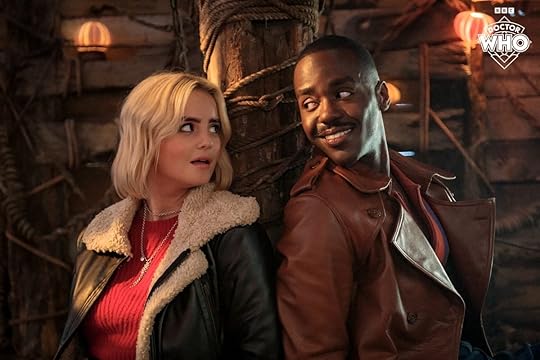 BBC Studios/Bad Wolf
BBC Studios/Bad Wolf That’s lovely. You mentioned a bit about the mystery surrounding Ruby. We get her background story in the holiday special and now know that there’s something going on with her mom. It’s quite interesting. I know you can’t spoil anything, but can fans expect to learn more about Ruby’s life as the show progresses?
Gibson: Yes, and I think Ruby learns more about her life as the show progresses. That’s what’s great about being the companion because you are the audience, you’re the eyes of what’s going on in the Doctor’s world. Things will begin to unfold. I’m excited to see fans’ theories of what it might be.
The Doctor Who fandom loves a good theory.
Gibson: I know, I know!
You know, the Doctor always helps a lot of people but only a few are chosen to be a companion. What do you think that the Doctor saw in Ruby Sunday that made him say, “I want her to be my new friend and my traveling companion.”?
Gibson: They connected when he realized she was abandoned too and were both foundlings in a way. They were both lost souls. I think as soon as he put Ruby to the test to see how she’d survive in a goblin ship, and I think she passed the test, and he must’ve just thought, “Actually, this girl’s quite fun.”
But I think it’s her courage as well. They meet properly when she’s in the sky on a ladder, so I think he just thought, “She’s a bit of me.” …their personalities bounce so well off each other.
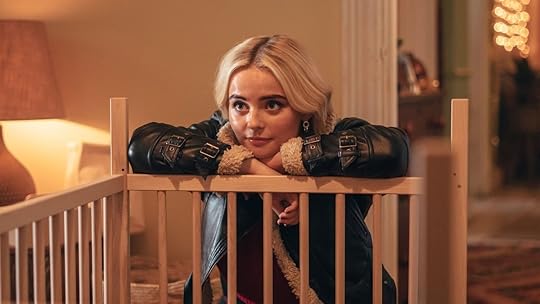 BBC Studios/Bad Wolf
BBC Studios/Bad Wolf Absolutely. The ladder scene is one of my favorites, by the way! Was that super challenging to film?
Gibson: Yeah! I’d never worked on wires before. Russell purposely wrote a line in just so I could put the jacket on so we could hide the wires under the costume. I think it’s when I’m like, “Oh, I’ll go to the shops,” …and then I just kept my jacket on… I’d never done anything like that before, it’s a good thing I’m not scared of heights! I loved it, I will say. I felt like a superwoman hero. But yeah, it was a super fun scene to film.
That sounds like a blast. My second favorite scene is, of course, when you and the Doctor start singing. What was it like filming that scene and how did you get ready for it?
Gibson: You know what? [Ncuti Gatwa and I] didn’t get ourselves ready! Genuinely, we both were under the impression we’d be filming it in post-production in a studio with a nice cup of tea. And they just went, “Okay, action.” And it was like, “Oh, right, we’re doing live? We’re singing live?” …We didn’t expect to sing it in the flesh but it worked… it all turned out great in the end with a bit of auto-tuning.
It was delightful! Now, how did it feel to step onto the TARDIS set for the first time?
Gibson: The whole scene outside, when I’m walking around the TARDIS being like, “How is it bigger on the inside?” That was actually my favorite scene to film. I remember it was a bit of a rush. We were losing daylight and we did it in one or two takes, I think. It was such an easy thing to film for me because as an actor, it was so surreal doing that reveal scene because it’s so iconic, the moment the companion realizes the TARDIS is bigger on the inside than the outside for the first time. I loved walking around it and just playing with my reactions. And then having Mrs. Flood say, “Good luck, Ruby!” was just such a heartwarming moment. It gives me goosebumps every time.
Seeing the TARDIS in the flesh was insane. I’m used to seeing David Tennant or Matt Smith’s type of brown rustic, really home living TARDIS. So when I saw this one, it was more like, “Oh my God.” It really fits our season. I think it really speaks for our show.
 BBC/Bad Wolf Studios/Disney+
BBC/Bad Wolf Studios/Disney+In what way does it fit the season?
Gibson: Like the jukebox, that’s so Ruby and the Doctor. Just boogying and deciding where else we want to go and things like that… I love our TARDIS even though it’s very clean.
Sounds like fun! If you could describe the adventures of this upcoming season in three words, which ones would you use?
Gibson: Dark. It does go quite dark. Musical and snow.
Interesting. Musical will be a delight. So many shows are going that route and I love it.
Gibson: Going with the times!
The post DOCTOR WHO’s Millie Gibson on Ruby Sunday’s Personality, a Dark Future, and Filming Fun appeared first on Nerdist.
Chris Hardwick's Blog
- Chris Hardwick's profile
- 132 followers



